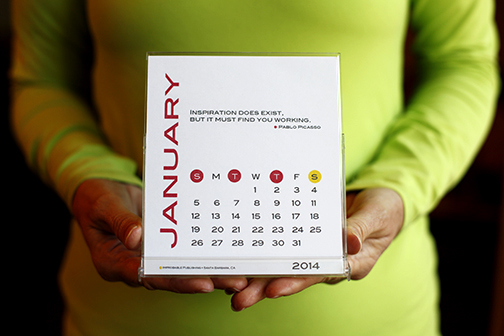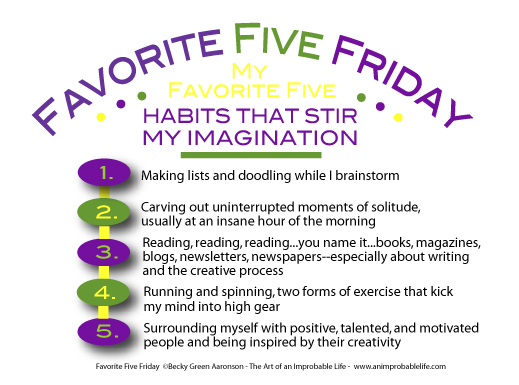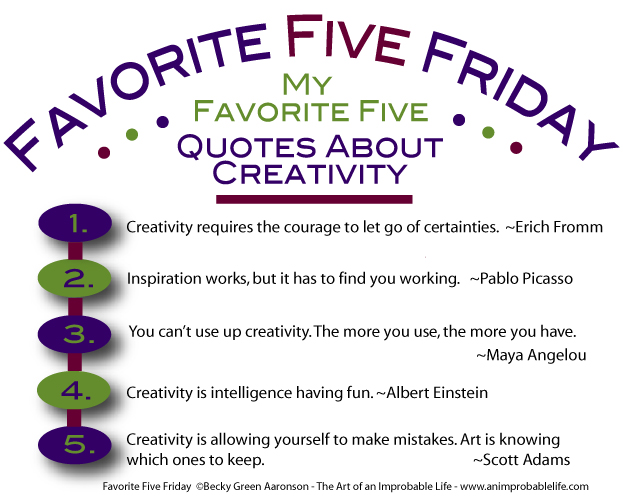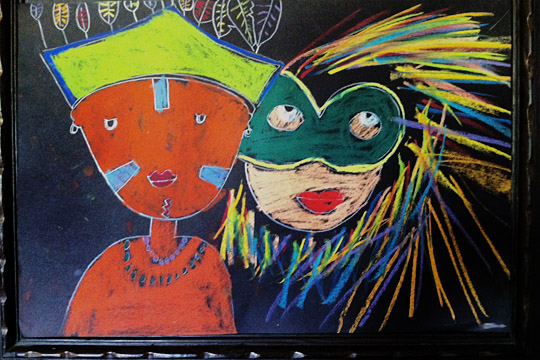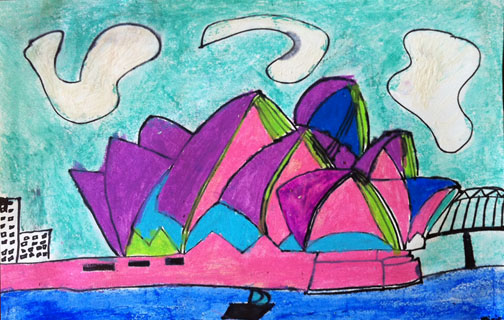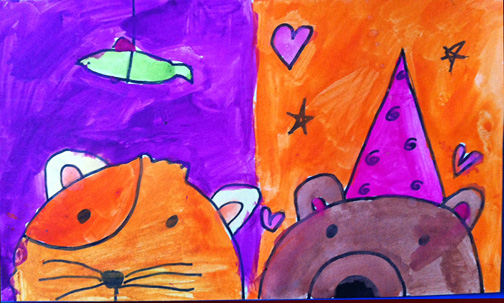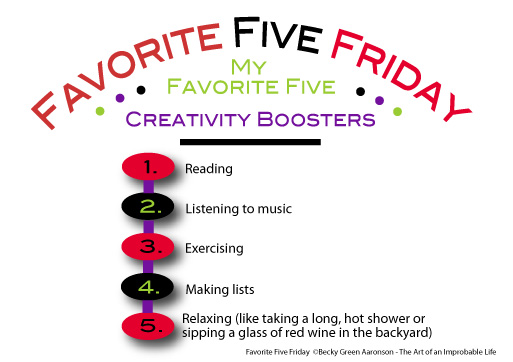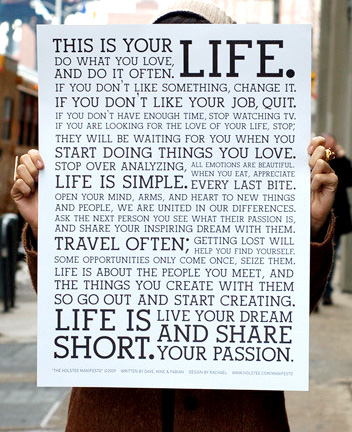I’m excited to share a new project with you, which combines many of my favorite things–designing, writing, and motivating others. It also celebrates the many inspiring people I surround myself with on a daily basis–artists and athletes. I’m especially happy because this project also lets me use my talents to help stand up to cancer. Here’s what I’ve been up to… Continue reading
Tag Archives: creativity
Favorite Five Friday: Habits that Stir My Imagination
It’s easy to be inspired, motivated, “on fire” when you first launch a project. When the glow of excitement fades though, you need to fall back on your habits to keep you moving in the direction of reaching your goal and completing your masterpiece. Here are a few habits I rely on to keep my imagination factory pumping and propelling me forward.
“Motivation is what gets you started, habit is what keeps you going”–Jim Rohn
What habits do you rely on to stir your imagination? Please share! When I wrote #5 on my list, I was thinking of many of you who often inspire me by the way you view the world.
Favorite Five Friday: Quotes about Creativity
As the magic of autumn begins sending its creative sparks through the air, I can think of no better time to share some of my favorite quotes about creativity.
What are your favorite quotes or ideas about creativity? Leave your comment in the comment box. I’d love to hear from you! Happy Friday everybody!
Positively Counteracting the Ninnies in Washington
This morning I was so filled with disgust about the toddlers running our government that I was ready to write a rant like no other. But then I stopped before I even got started, deciding that my writing tantrum would be akin to their childish behavior. And there’s nothing more absurd than grown, thinking people carrying on like two-year olds when they don’t get their way.
I also decided that I didn’t want to waste another ounce of my precious energy on all this negativity. So off went CNN. Away went every browser blasting headlines about the shutdown. And up went my blog.
Hello awesome peeps!
I decided the best way to counteract these ninnies in Washington is to surround myself with positive, creative, motivated people like YOU.
Don’t get me wrong, I’m mad as hell like everybody else, and feel our elected officials are an embarrassment to our nation right now, but I can see beyond these self-absorbed nitwits to our extraordinary country, which is brimming with smart, caring, talented and creative people.
So what do you think? Instead of giving our so-called “leaders” any more of our attention as they puff and spout and lay on the floor kicking their arms and legs, what do you say we tune them out and DWELL IN POSITIVITY? As in… Continue reading
Draw Your Lines Any (Damn) Way You Like, Sweet Bug
It has been a summer of art at our house. My hubby has been hunkered down in his art studio working away on his new project, I’ve been writing into the wee hours of the night, and our daughter has been painting her way through a swirl of art camps.
It has all been delightful.
That is until last week.
Book Review–Imagine: How Creativity Works by Jonah Lehrer
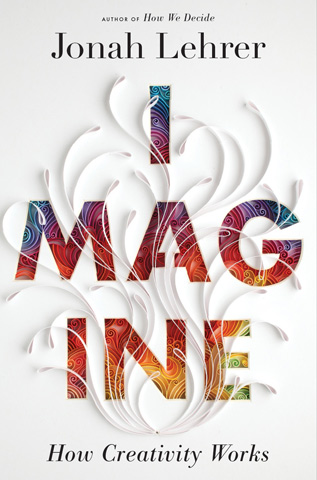 The other night I had the privilege of listening to author, Jonah Lehrer, speak about his best-selling book, Imagine: How Creativity Works.
The other night I had the privilege of listening to author, Jonah Lehrer, speak about his best-selling book, Imagine: How Creativity Works.
When 31-year old Rhodes Scholar and Wired editor, Lehrer, sauntered onto the stage at UCSB, smiled through his urban-hip geeky glasses, then started spewing insights in his highly-caffeinated manner, I felt like I’d just been hit with a double-espresso shot of inspiration.
Lehrer’s talk flowed just like his book, mixing neuroscience and entertaining anecdotes about famous creative breakthroughs and aha moments.
He shared stories about a wide range of characters—everyone from poets, musicians, and advertising executives to inventors, scientists and educators, deconstructing the process of how we accomplish some of our greatest feats of creativity.
 While Imagine has been blasted in several reviews for scientific inaccuracies (The Guardian and The New York Times, in particular), I find this book irresistible.
While Imagine has been blasted in several reviews for scientific inaccuracies (The Guardian and The New York Times, in particular), I find this book irresistible.
None of the information on its own is necessarily groundbreaking, but the way in which Lehrer presents it with his fine writing, connecting the creative dots, and making the science approachable for non-scientific readers, creates a book that is not only delightful, but enlightening.
I knew Imagine was for me when the author kicked off the first chapter describing the genesis of one of Bob Dylan’s best-known songs, Like a Rolling Stone. Dylan, who was burned out at the time—sick of his music and sick of other people’s expectations of him—got on his Triumph motorcycle sans guitar and headed to an empty house in Woodstock. There, after essentially quitting and letting it all go, he ended up creating one of the most inspired pieces of his musical career.
Lehrer hands us one entertaining anecdote after another then peppers it with science, explaining why a particular breakthrough may have occurred. There’s the tale of how masking tape was invented and other common items like Post-it Notes and the Swiffer mop, then there’s the story of how Nike’s famous “Just Do It” logo was created.
“Every creative journey begins with a problem,” he explains. “It starts with a feeling of frustration, the dull ache of not being able to find the answer. We have worked hard, but we’ve hit the wall. We have no idea what to do next…Thanks to how we’re hardwired, it’s often only at this point, after we’ve stopped searching for the answer, that the answer arrives.”
Haven’t we all experienced this in our creative lives? Just when we’ve nearly thrown in the towel, some nugget of inspiration has fallen into our laps and given us the spark we needed to keep going.
What I like about this book is that Lehrer challenges pre-conceived notions about creativity and tries to demystify the process. He believes we all have the ability to be creative if we cultivate certain thought processes, and if we apply a large dose of grit.
As a writer, I loved being reminded about the grit factor, the need to dig deep and be persistent, putting in hours of hard work—as in the “1 percent inspiration, 99 percent perspiration” notion. Best-selling memoirs don’t just magically happen. They take months, sometimes years of writing and re-writing.
Lehrer quotes neuroscientist, Nancy Andreasen, who says,
“Successful writers are like prizefighters who keep on getting hit but won’t go down. They’ll stick with it until it’s right.”
He also quotes famous graphic designer, Milton Glaser, who has the slogan ART IS WORK chiseled in the glass of his studio:
“There’s no such thing as a creative type. As if creative people can just show up and make stuff up. As if it were that easy. I think people need to be reminded that creativity is a verb, a very time-consuming verb.”
My timing in reading this book has been fascinating, as so many of the ideas have infolded in front of me while watching my husband agonize over the creation of an extremely complex piece of art he’s been working on for the past six months. Each part of the design, each medium he’s used (photography, paint, gouache, collage, paper, metal, ink, pencil), and each decision he’s made has been one of intense thought, piles of research, hours of learning new techniques, and even more hours of being hunched over his art table doing the work. Throughout this process he has hit the wall numerous times, felt like he’s lost his mind in even attempting to construct this concept. But just as it’s driving him mad, a solution comes—in the middle of the night, when he’s walking, when he’s listening to NPR, when he’s chatting with colleagues about random subjects, or when he’s looking at other’s art.
While Imagine isn’t a prescriptive book about how to be more creative, Lehrer does offer a few strategies about remaining creative over time:
- Travel—the longer the trip, the better.
- Embrace your status as an outsider. People who aren’t established and haven’t learned the system, often bring the freshest ideas. They don’t know anything so they aren’t afraid to make mistakes. Their “ignorance” or naïveté, gives them an advantage.
- Do the hard work then play, and then do it again, until the two are one process.
- Cultivate new colleagues.
- Embark on a new career or learn a new medium.
- Live in a city. Urban centers are hubs of creativity because populations are usually diverse and people continually rub shoulders, sharing ideas. Culture, he says, determines creative output, and it’s through sharing information and making connections that we maximize that output.
A few other fun tidbits culled from this book include: the color blue is said to increase creativity, as does caffeine, daydreaming, and relaxing. That must be why I do some of my best thinking in the backyard, sipping iced lattes while writing under blue skies; and why ideas always pop into my head while I’m relaxing in a long, hot shower or going on a delicious, meandering run. It’s all about the dopamine, baby!
The take-away message from this multifaceted book is that creativity is hard-wired in the human brain and we can enrich that quality in ourselves and in our society. “It’s time to create the kind of culture that won’t hold us back,” Lehrer says, “We have to make it easy to become a genius.”
If you’re looking for a book to inspire and stir your imagination, by all means read Imagine, especially if you love a good behind-the-scenes story about how things are created, and how some of our best creations have come from failures. If you’re searching for precise scientific data about how our creative minds work, this book might frustrate you with its reported errors and generalizations. Head to scientific journals instead.
I rate this book a solid 4.5 out of 5 stars.
What are your thoughts about this book? And what are your thoughts about Lehrer’s recent “self-plagiarism” controversy? Drop your two cents into the comment box. I’d love to know what you think.
©Becky Green Aaronson 2012
Favorite Five Friday: Creativity Boosters
Creative sparks come from many sources. When I’m trying to stir up some inspiration for my work, I always turn to my favorite activities. Here are the top five things that boost my creativity.
What are your favorite five ways of boosting your creativity? Take five minutes or less and drop your Favorite Five in the comment box. Happy Friday everyone!
A Tasty 10-Step Recipe for Creative Success
Ingredients
1 Open Mind
1/2 cup Inspiration
3/4 cup Talent
1 cup Originality
1 cup Authenticity
2 cups Motivation
2 3/4 cups Passion
4 cups Belief
4 cups Commitment
6 cups Perseverance
8 cups Grit
1 lb. Courage
Step One: Preheat imagination by clearing mind of clutter and doubt. Do this with an activity of your choice—run, meditate, take a long shower, relax with a glass of wine…
Step Two: Gather all ingredients, pour into large mixing bowl and stir with abandon. Get messy. Let it fly. Embrace the process, and never think about the cleanup.
Step Three: Season to taste using the textures of your soul. If your creation is bland, add a pinch of spice, a pound of raw emotion and one additional cup of grit. Blend vigorously until flavor is sublime.
Step Four: Knead it and work it, work it, work it.
Step Five: Set aside and let your ideas rise. During this important time, make an effort to engage in other activities, further stirring your creative juices: read, listen to music, go for a hike, surround yourself with art or other creative people.
If necessary repeat steps four and five.
Step Six: Once you are satisfied with the overall flavor and consistency, shape into the form of your choice—one that most expresses your passion and personality.
Step Seven: Bake in creative oven until done. Only you will know at what temperature and how long this will take. During this step, be sure to check it occasionally, but trust your instincts and refrain from continually opening and closing the oven door; that only lets out the heat, and often makes a masterpiece fall. Rather, relax and allow it to reach its natural golden state.
Step Eight: Remove from oven, and set aside to cool.
Step Nine: Once cool, embellish. This is your chance to add your final pinches of panache and swirls of sweetness. Make sure you have sprinkled it sufficiently with the yearnings of your heart, and topped it with the magic of your imagination.
Step Ten: Enjoy and celebrate your creative masterpiece, and most importantly, be sure to SHARE IT.
*Note: This recipe works best when creating purely to impress yourself. If others appreciate it too, then that’s just icing on the cake.
©Becky Green Aaronson The Art of an Improbable Life 2012
Is Social Media Killing Your Creativity?
Last night as I lay in bed counting sheep, two questions continually swirled through my mind.
- What has happened to my creative mojo?
- Why do I perpetually feel rushed, unfocused and unable to finish what I start?
It seems like months since a rich and textured story has poured out of me with grace and fluidity (at least on my best writing days). Now it feels like each word, thought, and gesture is clumsy and forced—as if I’m madly paddling down a river on a clunky, handmade raft, bumping into rocks all along the way.
Some would chock this up to writer’s block. I would disagree.
I would hand this dubious honor to the curse (and blessing) of social media.
Huh?! Whatcha talkin’ about Willis?
How could Facebook, Twitter and the likes change the flow of one’s creativity?
Simple. There is so much information out there now that our senses are being dulled like stones being tumbled along the bottom of a raging river. As the current of news and ideas continually grows wider and more intense, we are unable to keep pace with the pummeling flow.
I read somewhere that 290 million Tweets are sent each day, over 200 billion videos are viewed each month, and an estimated 100 billion photographs are now shared on Facebook. That’s a whole lot of sharing, and that doesn’t even include blogs or other forms of social media like Digg, Delicious, Tumblr, Squidoo, LinkedIn, or Pinterest.
To switch metaphors (because, as I mentioned I’m struggling with focus), social networking is like standing in the middle of a massive cocktail party in which everyone is talking loudly–all at the same time. Everybody is sharing their latest exciting adventures as well as their greatest discoveries, their juiciest gossip, their funniest jokes, their most heart-warming stories, and their mountains of indispensable advice. The din is mesmerizing. The only problem is that it’s so noisy it’s often difficult to decipher what anybody is saying. It’s also nearly impossible to gather your thoughts to contribute to the conversation in any meaningful way.
After leaving the party, you likely feel dizzy and a tad unfulfilled as random bits of conversations still float through your head. When you get back home and try to write, you realize you’re suddenly nursing a hangover from this gathering. It wavers between a dull haze and a nagging headache. As you rub your temples and try to keep your mind from jumping from thought to thought, you attempt to settle into a creative writing rhythm. It doesn’t happen though, so what do you do? Check your email, of course. Responding to a friend’s or colleague’s message is much less taxing than creating an original thought on a blank screen. Then one thing leads to another and viola, you’re suddenly back in the middle of that noisy party again.
Some would say, “Get a grip, girlfriend. Just turn it off. Drop out. Get back to your creative center.
And they would be right.
Well, sort of.
As an author, social networking provides an important outlet for connecting with readers and like-minded writers. Since I joined the world of blogging and social media last year, I have met some truly phenomenal people—people like you—many of whom I never would have met otherwise. For that I am grateful. Your support, enthusiasm, and generosity have added value to my life in ways I never would have imagined. I genuinely enjoy connecting with you.
The problem is that because you have been so supportive and I’ve come to enjoy you so much, I want to reciprocate. I’m interested in what you’re up to and look forward to reading your latest book, blog post, and Facebook entry. I want to comment and share with others how talented you are. I want to send you a virtual high five for receiving a rave review or winning a much-deserved award. Most of all, I want to say, “thank you.”
But all of this takes time, and a different style of writing, which splinters my focus and makes me feel perpetually rushed and distracted. Instead of writing long, delicious prose, I’m focused on writing brief, clever comments, and communicating in 140 characters or less. I no longer lose myself in a story I’m writing, inhaling the details of the imagery, exhaling the textures of the characters and dialogue.
So what’s a girl to do to get her creative mojo back?
The obvious answer is to turn off and drop out, but that’s tough for somebody who likes to mix it up and party with talented people. Perhaps create first, party later? I know what else I must do. It’s what I always do when I need inspiration: read. Finding a calm eddy in the torrent of social media and immersing myself in the world of literary fiction will no doubt stir my creative soul once again.
So tell me, do you feel like social media is killing your creativity? What is your approach to it all? Are you able to participate in virtual social circles, then transition into a different way of thinking and being creative? Drop me a comment. I’d love to know what’s buzzing through your mind.
This is Your Life…
You may have seen this before, but it’s worth taking a peek at the Holstee Manifesto again. It’s one of my favorite tidbits floating around the web so I thought I’d share it with you.
This video version below is especially fun if you like typography.
Happy Sunday everybody. Now get out there and create something!

